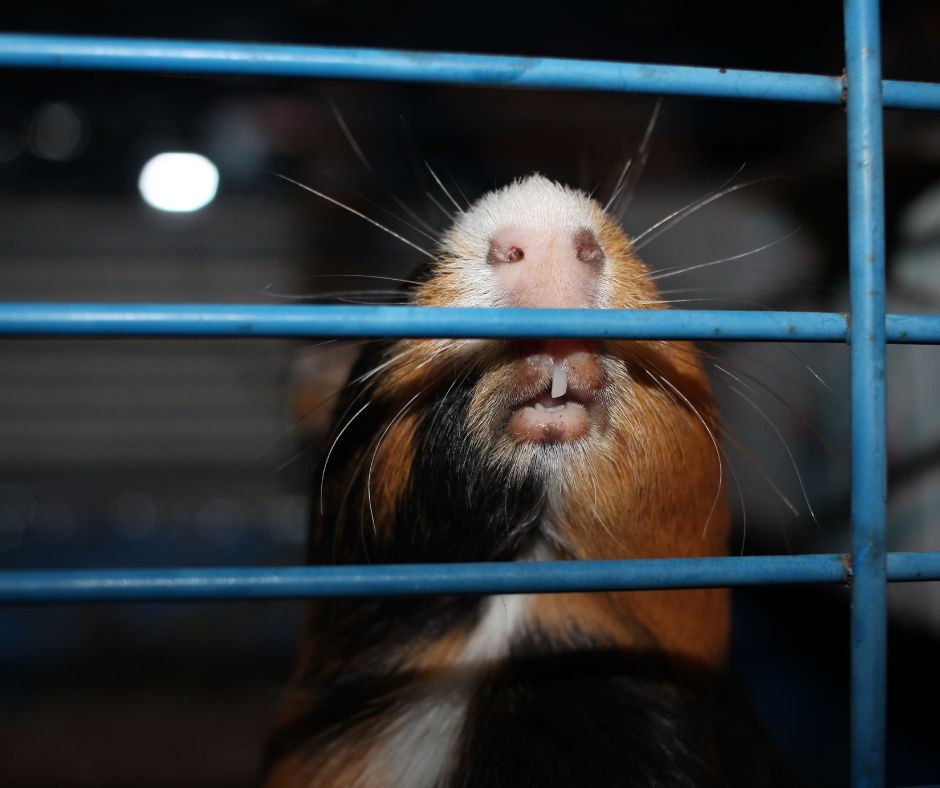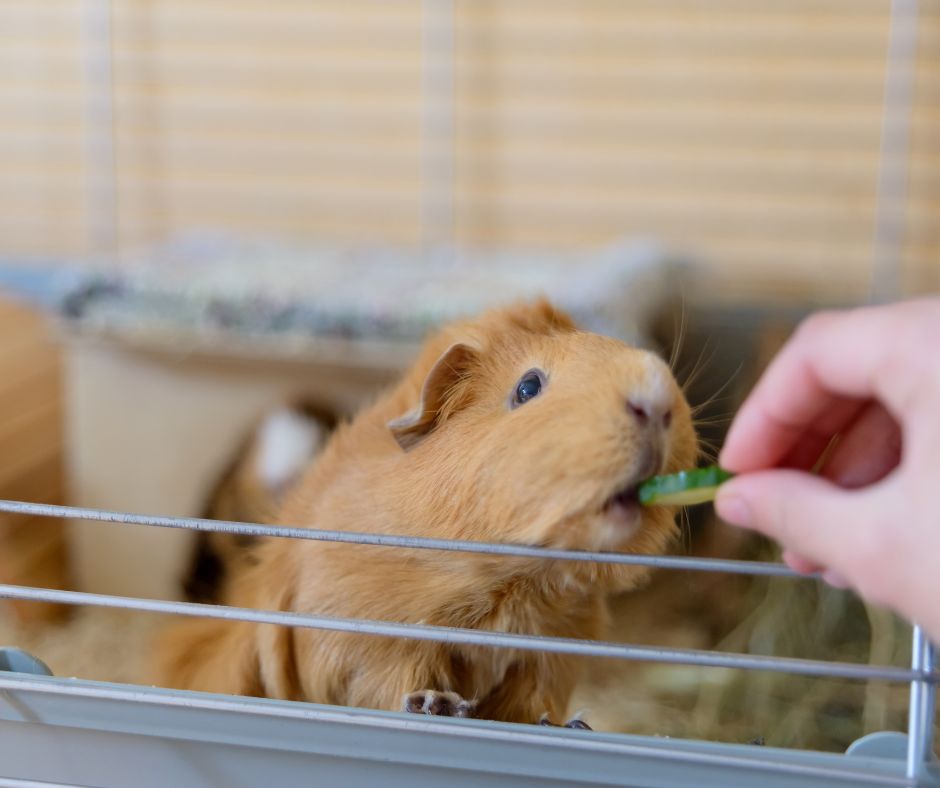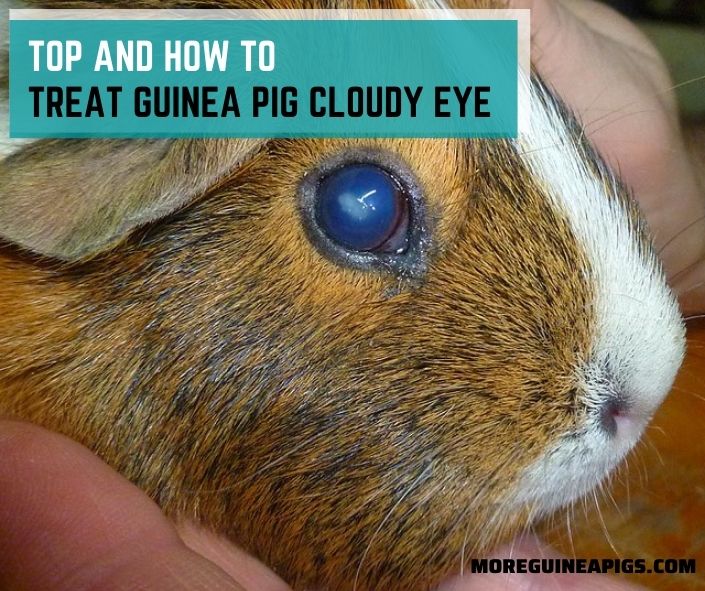3 Advice for Owners When a Guinea Pig Injured After Fall
Many things can hurt a guinea pig, including falling from a height. As much as we humans crave a hot drink to warm ourselves on cold days, guinea pigs pant to climb more than anything.
They like to ascend on ramps and steps and seek a high place to sit up high to observe their surroundings. And when these pet piggies get excited, they express their emotions through jumping.
Guinea pigs hardly jump down from a very high place for fear of heights, but they can fall and injure their fragile body. So, how do you manage guinea pigs’ injuries?
Below are 3 key pieces of advice for owners when a guinea pig injured after falling. Read on for enlightenment!
3 Advice for Owners When a Guinea Pig Injured After Fall

Falling is one principal cause of injuries in guinea pigs. They will be tempted to jump down from many places, especially their cages (not exceeding 10 inches), if something frightens them or they are excited.
Note that your piggy could jump out of your couch or bed for the same reasons. It could also jump or fall from your arms, kitchen’s work surface, sink (when bathing), balcony if chased by a dog, etc.
Unfortunately, if the heights are too high (˃15-20 inches), your pet may hurt itself. The risk of breaking or dislocating a leg is too high at such heights.
Moreover, if the pet attempts several jumps and falls, it could risk its bones becoming more fragile. Eventually, your guinea pig might be prone to arthritis at its old age. It’s not safe for guinea pigs to fall!
Other potential injuries for guinea pigs falling from very high places include;
- Fractures
- Paralysis
- Internal injuries
- Death (in extreme cases)
In case your guinea pig falls, act as a caring person. Examine the pet to make sure there are no injuries. However, if you notice unusual signs such as limping or not eating well, your piggy needs help.
Check and Determine Where Is the Injury
Your beloved guinea pig falling can be overwhelming. I know how you love your animal friend! However, we advise people not to panic but to calm down, take a deep breath, and have time to inspect the curvy for injuries.
By falling from height and being unable to absorb the shock, guinea pigs are at the risk of tooth fracture and paralysis.

Signs and symptoms that indicate paralysis or broken bones in guinea pigs include:
- Closed fracture
- Open (formerly known as compound) fracture
- Sprain
- Dislocation
- Other types of orthopaedic injuries, e.g., a broken leg (bone protrudes through the skin or you notice limping that lasts for more than a day), not moving, squeaking in pain and dragging its leg.
More gravely, if your pet piggy falls on its buttocks, the result may be spinal fracture and disc rapture, which eventually causes hind leg paralysis.
After crushing the spine, the animal may start experiencing spinal nerve problems, loss of back legs sensitivity, and begin to urinate on them. So painful and unbearable for many caretakers!
Falling also exposes guinea pigs to teeth fracture. They can break one or more teeth, affecting their feeding behavior. Your guinea pig won’t be able to eat, requiring you to feed it with liquid food only.
The pet piggies who live on a poor diet are more prone to broken teeth due to vitamin C deficiency, essential for strong bones and teeth.
Your guinea pig may not have broken teeth or bones but suffers from internal injuries resulting from the fall. You will know this if your pet cries with pain or screams when you touch it.

Apart from squeaking in pain, check out for other signs of pain and illness as follows:
- Reluctance to move
- Fast breathing
- Drooling
- Squinting eyes
- Hunched appearance
- Teeth grinding.
Book Appointment with Your Vet Right Away
Most guinea pigs will squeal if they’re experiencing potential pain; they can’t take the pain any longer. Something else to recall is that severe injuries in guinea pigs do not heal on their own.
So, if your guinea pig accidentally falls and you suspect it broke its bones or teeth or have other complications, you need to see a vet as soon as possible.
The vet may choose to administer pain relief to alleviate the pain and make it possible to handle the piggy for x-ray and perform fracture diagnosis. Sometimes the pig may be anaesthetized or not.
The type or level of treatment varies depending on various factors, including presence or absence of fracture, place of fracture, how distressed the piggy is, difficulty passing urine and feces, etc.
Below are the different types of treatments your pet may be subjected to and their recovering period.

Bleeding Wound Treatment
Regardless of the injury or wound size, the vet deals with it quickly. For minor injuries, it’s best to keep them clean and dry.
It’s enough to clean minor wounds with saline water to remove foreign objects and then sterilize them.
If bleeding progresses, the next thing will be to exert pressure on the affected part using a clean paper towel or gauze pad for 3-5 mins. It will encourage clotting with no interruption. It should stop after around 10-15 mins.
Tooth Fracture Treatment in Guinea Pig
Your vet will also offer treatment for tooth fracture. He will trim the jagged and sharp teeth to prevent the piggy from cutting its delicate oral tissues. For the damaged oral tissues, the vet cleans them out to avoid an infection.
For healthy pet piggies, their broken teeth should grow just fine. Things don’t just end after trimming the tooth, but a follow up is needed. The vet monitors the regrowth of the tooth to make sure it’s growing properly.
The growing tooth should match up with the rest of the teeth. Otherwise, further trimming will be necessary, especially if the matching tooth on the opposite jaw tends to overgrow. The vet will trim it too.
If your guinea pig cannot eat properly, the vet recommends hand feeding. It is done by mixing meshed pellets with water and then a syringe to squirt the mixture into the pig’s mouth.

Broken Bones Treatment in Guinea Pig
Your vet will expose the pig to an X-ray to locate the broken bone. It’s not always easy to spot a fracture without an X-ray.
If it’s the leg that’s broken, the vet may splint it or perform surgery to place pins in it for support until it heals. Unfortunately, amputation may be recommended if the leg doesn’t respond to healing and can’t be repaired by surgery.
If your guinea pig suffers from severe pain and cannot heal, the vet may commend compassionate euthanasia. No caretaker is ready to welcome such an idea, but it’s the only solution if there’s no other healing option.
After your pig begins its treatment, you will need to care for it and continue with the treatment at home. Your savvy vet will advise you on how to go about everything.
Internal injuries Treatment in Guinea Pig
Internal injuries, e.g., internal bleeding, may happen due to a fall. Internal bleeding, for example, can be more challenging to spot and require special examination.
The vet performs a blood test or scans to check for internal bleeding. Not severe bleeding will stop on its own; the furthest advice here is to leave the pig to rest and keep watch on it.
Some bleedings are severe and may require surgery to stop the bleeding and clean out any pooled blood.
The type of surgery or treatment varies depending on the organ affected. The healing period depends on the severity of the injury.
First Aid for Guinea Pig Injured After Fall
What should you do if your veterinarian is not available at short notice? Do nothing and wait for him to come? Of course, no! As you know, the pain will torment the piggy to death before it gets to the vet.
Therefore, you have to provide first aid to make the pig more comfortable until it can get more help from the vet.

First Aid for Small Bleeding Wounds
Typically, small bleeding wounds can heal through proper home care. The first and foremost approach for the small bleeding wound is disinfecting it. For instance, saline solution is a natural disinfectant and is effective in guinea pigs.
You can also disinfect the wound with “Rivanol”, “Betaisodona”, or an antiseptic ointment; if the wound continues to bleed, apply firm pressure to the area. You would want to use a paper towel on top of the wound till it’s completely dry.
First Aid for Tooth Fracture
In some cases, your guinea pig may break its tooth from a fall. With a broken tooth, the guinea pig experiences difficulty in eating.
Proper first aid for tooth fracture will be to flush any food out of the hole. Then, clean the place with saline water as you wait to see the vet.
First Aid for Broken Bones
Watching a guinea pig with a broken bone can be devastating, especially when under extreme pain. Though tempting, do not apply a splint yourself since moving an injured piggy can cause further damage.
Give pain medication and anti-inflammatory. Gabapentin, non-steroidal anti-inflammatory, tramadol, and amantadine are effective pain relief medicines and reduce inflammation. The best way is to contact your vet to guide you on using them.
Stop any bleeding by applying direct pressure on the injured area. Open fractures need to be covered with a sterile gauze dressing.
Please be careful when caring for a guinea pig with broken bones. Below are 3 don’ts of first aid for broken bones:
- Don’t flush the wound with saline water.
- Never try to set or reduce a fracture. You may end up hurting your pet more.
- Do not give any over-the-counter (OTC) pain medications as some may cause bleeding or delay the wound healing.
4 Tips to Avoid Guinea Pigs from Falling?
It’s good to be prepared for anything since accidents don’t knock; they happen without warning. However, it’s still possible to protect your guinea pig and reduce the chances of it falling.
Below are 4 tips or precautions to take to prevent your guinea pig from falling. The Fall of guinea pigs is the last thing you want.

Setup Your Guinea Pigs’ Cage with Lid Higher (15 Inches)
First of all, provide a cage with ample space, and the walls should be as high as 15 inches. A lid or top cover is necessary to keep other household pets out.
These are the closest animals that can threaten guinea pigs. If it’s possible, keep your piggies very far away from other pets.
Likewise, installing the cages a little higher allows the guinea pigs to view their surroundings without climbing the room.
Stay With It at All Times When You Take Your Guinea Pig Out of Its Cage
After taking your beloved piggy out of its cage, it is advisable to stay with it at all times. Many things can happen by letting the guinea pig roam about the house or compound.
Sometimes your cat or dog may chase the pig, and it ends up hurting itself while escaping. Also, children love playing with guinea pigs and can be clumsy with handling them.
They may also let the guinea pig fall if it bites them. Monitor the kids when handling a guinea pig and make sure they sit down first.
Guinea Habitat Guinea Pig Cage by Midwest
Be Careful When Handling
Handling your guinea pig well will also help to avoid falls. Always use your two hands in the picking process.
To restrain it, use one hand to stop the piggy from running forward and the other to prevent it from backing up. Place one hand under the piggy’s chest and abdomen, and use the other hand to support its hindquarters and weight.
Avoid using paper towels or fabrics other than your clothes to pick your guinea pig. The material may slip out of your hand and fall together with the pig.
If the pig bites or scratches you, don’t let it fall. Be ready to bear the pain until you place it back in its cage. And do it gently!
Don’t Set Everything Too High
It’s not uncommon for guinea pigs to jump out of the sink when they are bathing, especially if you leave them alone and go to get something, e.g., towel, shampoo, etc.
I would advise you to use small basins, not too high, and place them on the ground to bathe the pig. It’s the safest way to go, especially if the piggy has its bath for the first time. That way, you will avoid surprising it.
If you’re using hammocks in the cage, opt for sturdy ones and can be placed pretty low to the ground to avoid any unpleasant falls. Set everything lowest to the ground as much as you can.
Jamktepat 4 PCS Guinea Pig Cage Liners Guinea Pig Bedding
In Summary
Guinea pigs are prone to falling and can fall from many places, e.g., from your bed or sofa, coffee table, cage, arms, balcony, sink, hammock, etc.
Always be ready to intervene if your pet piggy falls from a height and check if it got hurt. If you suspect any fracture, be sure to seek help from your vet immediately. A guinea pig’s fall could be fatal.
Preferably, always keep your guinea pigs at a height that never exceeds 15 inches to prevent nasty falls. Handle your guinea pig properly at all times, and don’t let the children mishandle it. Teach them how to go about it.








